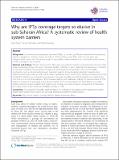Why are IPTp coverage targets so elusive in Sub-Saharan Africa? A Systematic Review of Health System Barriers
View/
Publication Date
10/3/2013Type
Article, Journalviews
downloads
Metadata
Show full item recordCitation
Thiam et al.: Why are IPTp coverage targets so elusive in sub-Saharan Africa? A systematic review of health system barriers. Malaria Journal 2013 12:353
Abstract/
Background: Use of intermittent preventive treatment (IPTp) is a proven cost-effective intervention for preventing malaria in pregnancy. However, despite the roll-out of IPTp policies across Africa more than ten years ago, utilization levels remain low. This review sought to consolidate scattered evidence as to the health system barriers for IPTp coverage in the continent. Methods and findings: Relevant literature from Africa was systematically searched, reviewed and synthesized. Only studies containing primary data were considered. Studies reveal that: (i) poor leadership and governance contribute to slow decentralization of programme management, lack of harmonized guidelines, poor accountability mechanisms, such as robust monitoring and evaluation systems; (ii) low budgetary allocation towards policy implementation slows scale-up, while out-of-pocket expenditure deters women from seeking antenatal services that include IPTp; (iii) there are rampant human resource challenges including low staff motivation levels attributed to such factors as incorrect knowledge of IPTp recommendations and inadequate staffing; (iv) implementation of IPTp policies is hampered by prevailing service delivery barriers, such as long waiting time, long distances to health facilities and poor service provider/client relations; and (v) drug stock-outs and poor management of information and supply chains impair sustained availability of drugs for IPTp. Conclusions: For successful IPTp policy implementation, it is imperative that malaria control programmes target health system barriers that result in low coverage and hence programme ineffectiveness.
Further Details
© 2013 Thiam et al.; licensee BioMed Central Ltd. This is an Open Access article distributed under the terms of the Creative Commons Attribution License (http://creativecommons.org/licenses/by/2.0), which permits unrestricted use, distribution, and reproduction in any medium, provided the original work is properly cited.
Publisher
BioMed CentralCollections
- General - GEN [367]

